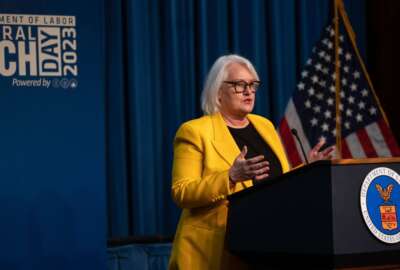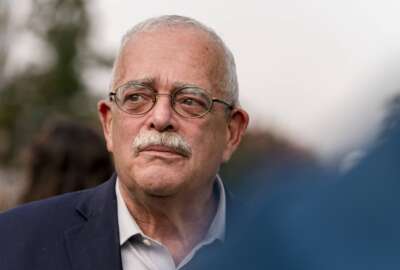Hubbard Radio Washington DC, LLC. All rights reserved. This website is not intended for users located within the European Economic Area.
Reporter’s Notebook: 5-year anniversary and the Top 10 of 2017
News about DoD’s Common Access Card, IT modernization and cybersecurity were the most popular notebook items last year.
The Reporter’s Notebook turns 5-years old this month. With more than 9,800 dedicated subscribers and thousands of other readers, I want to use this first notebook of 2018 to thank everyone for their support and words of encouragement over the years.
The Reporter’s Notebook started five years ago as a way to flush out and highlight news and information that was “getting lost in the shuffle,” or in my case buried in my 8×11 pads of paper— now in my laptop.
It has since morphed, first and foremost into much-needed analysis of federal IT and acquisition news. It’s also the place to go to find the “people on the move” in the federal community. One thing I’ve come to understand in almost 20 years of covering this community, people like people news. And finally, it has developed into an outlet to address some of the biggest and ongoing frustrations and challenges in the federal market — have I mentioned by soapbox of the lack of transparency in the General Services Administration’s schedule and other multiple award contract programs lately?
As I’ve said from the beginning, this is not a column nor commentary — it’s news tidbits, strongly sourced buzz and other items of interest that have happened or are happening in the federal IT and acquisition communities.
As always, I encourage you to submit ideas, suggestions, and, of course, news to me at jpmiller@federalnewsradio.com.
Here are the top Reporter’s Notebook stories for 2017:
- DISA’s plan to replace CAC to come together this year. Any story about the Common Access Card seems to strike a chord among Defense Department employees. The CAC is so intertwined in the everyday lives of military and civilian employees that any real or proposed changes are big news.
- White House’s new 36-point plan to modernize federal IT. The Trump administration’s plan to get agencies off legacy systems started to come together in the fall with this draft plan. Since then, the White House’s Office of American Innovation released the final strategy and further described its Centers of Excellence approach to implementation. Along the way, Congress passed and President Donald Trump signed the Modernizing Government Technology (MGT) Act in to law giving agency chief information officers a new tool to pay for these upgrades.
- Hiring of IT workers is flat, so CIO Council trying to give it a jumpstart. The CIO Council’s job fair last fall is one of the biggest success stories of 2017. It expanded on the Homeland Security Department’s hiring fair concept and proved that a whole of government approach to hiring can make a difference.
- Modernizing Government Technology Act to get second path to passage in Senate NDAA. The aforementioned MGT Act continued the push by lawmakers to further expand the authorities of agency CIOs. What will be interesting in 2018 is how agency CIOs use the working capital funds that the MGT Act created. Rep. Will Hurd (R-Texas), the main author of the law, said he will add MGT Act implementation to the Federal IT Acquisition and Reform Act (FITARA) scorecard as a way to drive accountability.
- CDM Phase 3 complexities causing DHS, GSA to rethink approach. The Homeland Security Department’s continuous diagnostics and mitigation (CDM) program is one of those stories that has long legs. But this one stood out because it was the first time DHS and GSA publicly discussed why they need a new approach to CDM. CIOs, chief information security officers and industry will get a better idea over the next six months as GSA releases the DEFEND solicitations on the Alliant governmentwide acquisition contract whether this approach will work. There is a lot of continued interest in CDM so expect 2018 to be another busy year.
- OASIS program personnel shakeup continues GSA’s Federal Acquisition Service upheaval. Without a doubt, GSA bore a tumultuous 2017 particularly around personnel changes. This story came after the former Commissioner Tom Sharpe and Deputy Commissioner Kevin Youel Page of the Federal Acquisition Service left unexpectedly a month before. The OASIS professional services contract vehicle is a popular program, bringing in $3.2 billion in agency contract obligations and exceeding its goal by $1 billion in fiscal 2017. The question in 2018 is whether these personnel changes will impact OASIS or were the concerns raised by contractors for naught.
- 12 stats that tell you about the State of Federal IT. As one of the last acts as federal CIO, Tony Scott left the Trump administration a roadmap for fixing federal IT. The idea was ingenious and one this and future administrations should copy. One big story in 2018 will be whether the Office of American Innovation, with its IT modernization strategy and CoEs, can build off of these lessons learned or take a step back to learn the same lessons that Scott and others have handed down.
- Should other CIOs be concerned about what happened to Treasury’s Bhagowalia? To me, this was one of the biggest stories of the year and foretold the changes coming to the federal CIO community. Sonny Bhagowalia remains at the Bureau of Fiscal Service as a senior adviser, and we’ve seen other shoes drop in the form of changes at the departments of Agriculture, State, Defense and at specific bureaus. The lack of a federal CIO, federal CISO and federal CTO as well as six cabinet level agencies still without permanent CIOs remains a major shortcoming of the Trump administration’s IT modernization plan as we enter into 2018. By the way, the Treasury Department quietly named Eric Olson as its deputy assistant secretary for information systems and CIO in November.
- GSA, DHS begin to tip their hand about future of CDM program. As mentioned above, the CDM is the program that keeps giving news and interesting changes. What stood out about this story is once again GSA and DHS began to flesh out the details about the future of CDM and the frustration of releasing a request for information just to Alliant small business contract holders instead of the broader contracting community to get input on critical changes a major program. This is a common frustration in the federal community and the reason why so many large multiple award contracts come under bid protest because if you are not in, you are out.
- Alliant 2 and other billion-dollar contracts worth watching this fall. This is the one story that surprised me the most making it into the top 10. Maybe it’s the headline mentioning “billion-dollar contracts,” or maybe it was the timing of story — so many were waiting for an update on Alliant 2 — the acquisition community will have a lot on its plate in 2018. It will be more than just large contracts, but changes to how agencies buy and vendors sell their products and services is well worth watching in 2018.
So there’s your top 10 Reporter’s Notebook stories for 2017. Over the next 12 months, we will continue to analyze and help you better understand the trials and tribulations of the federal IT and acquisition communities. Stay tuned, it will be a fun ride.
Read more of the Reporter’s Notebook.
Copyright © 2024 Federal News Network. All rights reserved. This website is not intended for users located within the European Economic Area.
Jason Miller
Jason Miller is executive editor of Federal News Network and directs news coverage on the people, policy and programs of the federal government.
Follow @jmillerWFED
Related Stories
Related Topics
Related Stories
-
Education, DHS among agencies seeking new IT leaders Reporter's Notebook
-
Federal CIO Martorana’s top 3 priorities for 2024 Reporter's Notebook
-
3 takeaways from the FITARA 17 scorecard roundtable Reporter's Notebook





